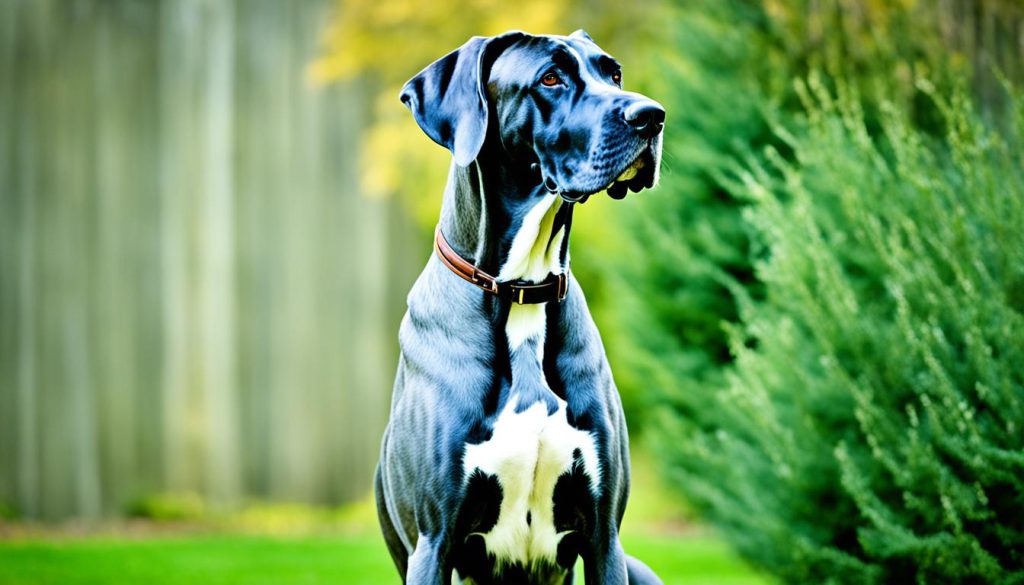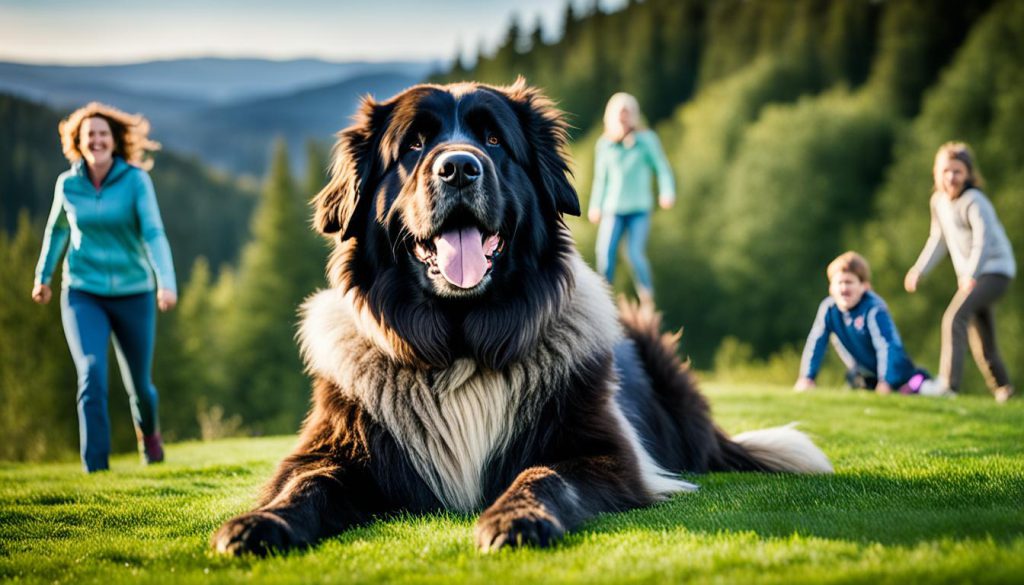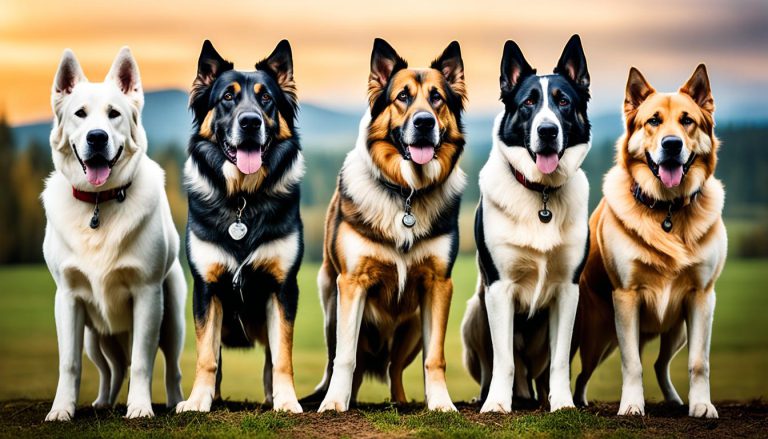My first Great Dane was a giant, at 32 inches tall and 150 pounds. However, he surprised me with his gentle heart. Despite their size, large dogs like him are calm and loving.
Great Danes, Mastiffs, and Saint Bernards bring so much joy. Yes, they need more of everything – space, food, and even vet care. But they give back so much love. Sadly, they don’t live as long as we wish. Yet, every day with them is priceless.
Key Takeaways
- Large dog breeds offer loyalty, protective instincts, and gentle temperaments.
- Despite their size, they are often affectionate and great with families.
- They require more space, more food, and incur higher veterinary costs.
- Large dog breeds like Great Danes and Mastiffs typically have shorter lifespans.
- The companionship they offer is invaluable, making them worth the investment.
Introduction to Large Dog Breeds
Imagine giant dogs: towering, strong, and a bit intimidating at first. Yet, these large dogs love to be part of the family. Despite their size, their kindness and love always come through.
This makes them great friends.
The diversity among large dog breeds is amazing. Take the Bernese Mountain Dog and the Alaskan Malamute, for example. While different, both are gentle giants.
Then there’s the Portuguese Water Dog and the Irish Water Spaniel. Their size doesn’t limit their personality.
Many think large dogs need big homes. But some large breeds do well in apartments. Like the Great Dane and the Leonberger. They just need regular exercise and mental challenges.
These dogs show that even big breeds can live in small spaces.
Here is a comparative table showcasing different categories of large dog breeds along with some facts:
| Category | Examples | Key Features |
|---|---|---|
| Hypoallergenic | Afghan Hound, Giant Schnauzer | Minimal shedding, allergy-friendly |
| Low Shedding | Bergamasco Sheepdog, Briard | Requires less cleaning, allergen control |
| Fluffy | Akita, Belgian Turvuren | Thick coats, cuddly appeal |
| Skinny | Great Dane, Greyhound | Lean build, swift runners |
| Black Coats | Newfoundland, Rottweiler | Striking appearance, strong and bold |
| Long-Haired | Alaskan Malamute, Leonberger | Flowing fur, majestic looks |
Looking for a large dog breed? The choices are wide and wonderful. These dogs show size doesn’t limit them. It’s about their heart and how well they fit into various homes.
Great Dane: The Epitome of Gentleness
I’ve always looked up to large dog breeds for families. The Great Dane stands out as a gentle giant. Despite their large size, they’re known for being sweet and loyal. This makes them perfect for families wanting a kind guardian.

Physical Traits
Great Danes are impressive in size. These giants can be up to 32 inches tall and weigh between 110 to 175 pounds. They have coats in colors like brindle, fawn, and harlequin. This adds to their majestic look.
They’re not just tall; their gentle nature makes them unique. Unlike other big dogs, Great Danes are perfect for families.
Temperament
The Great Dane is incredibly affectionate. They are friendly and fun, making them great family pals. Their loyalty is strong, and they get along well with other pets. This is ideal for households with more than one animal.
Great Danes are a true testament to the term gentle giants. With a soft heart, they stand out.
Keeping these dogs healthy requires good food and regular vet visits. The site GreatDaneLady.com offers great tips on diet and healthcare. With over 40 years of research, GreatDaneLady.com helps extend their lives well beyond the earlier expectancy.
In the end, Great Danes capture our hearts not just with their looks but also with their kind and loyal nature. They truly define what it means to be a gentle giant. They’re among the best big dog breeds for any family.
Mastiffs: Robust Yet Affectionate Companions
Mastiffs are seen as top large dog breeds for good reason. They’re big but surprisingly gentle. They offer both protection and love, making them great pets.
Physical Traits
Mastiffs stand out with their size. They weigh between 120 and 230 pounds and are over 28 inches tall. They have short, dense coats in colors like apricot and fawn, adding to their majestic look.
Despite their size, Mastiffs’ kind spirit is evident. This makes them less daunting than one might think.
Temperament
Mastiffs are both protective and loving. This makes them a top choice for families and first-time owners. They are extremely loyal and gentle with kids and pets.
Their size might not suit small homes. Yet, their calm and easygoing nature often compensates for it.
Mastiffs blend strength and gentleness well. They’re a top pick whether you’re a first-time owner or looking for a large breed.
Newfoundlands: Family-Friendly Protectors
Newfoundlands are large dogs loved for their gentle nature and protective instincts. They are great for families. Even with their big size, they are peaceful yet alert protectors.

Physical Traits
Newfoundlands stand out among large dog breeds. Adult males can weigh up to 130-150 pounds and reach 28 inches in height. They have a thick, water-resistant coat that’s rough outside and soft inside. This coat can be black, brown, gray, or white and black (Landseer).
These dogs have webbed feet and broad chests. Their large lungs make them excellent swimmers. This suits their role in water rescue work.
Temperament
Newfoundlands are smart and kind. They’re great protectors for families. They know how to guard children safely and can tell when there’s real danger.
They adore their families but need regular exercise to avoid health problems. Without company, they may get anxious. Thus, it’s key to spend plenty of time with them.
| Characteristic | Description |
|---|---|
| Weight | 130-150 pounds (adult males) |
| Height | Up to 28 inches |
| Coat | Dense, water-resistant double coat |
| Skills | Strong swimming and water rescue |
| Temperament | Intelligent, gentle, vigilant |
| Health Issues | Hip and elbow dysplasia, obesity, heart problems |
| Notable Owners | Ulysses S. Grant, Rutherford Hayes, James Buchanan |
Bernese Mountain Dogs: Gentle Cart Pullers
Bernese Mountain Dogs come from the Swiss Alps, especially the canton of Bern. They are known for being gentle and warm. These large dogs weigh between 86 to 110 pounds, depending on if they are male or female. Their beautiful coats are a mix of black, white, and tan.
Physical Traits
These dogs stand between 25 to 28 inches tall and are very strong. They can weigh up to 120 pounds. Their thick coats are great for cold weather but not for hot climates. Due to their thick fur, they shed a lot and need to be brushed often.
Temperament
Bernese Mountain Dogs are known for being really gentle and friendly. They get along well with other animals, but sometimes males don’t like other males. They are great for families because they are not aggressive. Training these dogs can be slow but they are good-natured. Sometimes young males can be stubborn. They need regular training and to be around other dogs and people.
This detailed overview gives you all the important facts about Bernese Mountain Dogs:
| Attribute | Details |
|---|---|
| Average Height | 25-28 inches |
| Weight Range (Males) | 86-110 pounds |
| Weight Range (Females) | 79-110 pounds |
| Life Expectancy | 6-8 years |
| Exercise Requirement | Minimum of 30 minutes per day |
| Health Concerns | Cancer, Hip and elbow dysplasia, Arthritis, Joint diseases |
| Food Recommendation | 3 to 5 cups of high-quality dry dog food per day |
| Endurance | Not a high-endurance breed, over an hour of exercise per day split between multiple sessions |
| Running Miles | Up to four miles in cool weather |
Large Dog Breeds: General Care and Living Considerations
Caring for large dog breeds is special. They need more space due to their big size. They often weigh between 100 to 200 pounds. And, they take up to 24 months to fully grow. Their need for space means they also need room to move and play. Exercise is key for their health and happiness.
Feeding big dogs right is crucial. They need food made just for them to avoid bone problems. Since they eat more, it can cost more to feed them. Also, they should see the vet one or two times a year. This helps catch any health issues early on.
Exercise is a must for them. They should go on walks one to two times a day. Playtime is also important to stop bad habits like digging or chewing. Owning a big dog means spending more on food, toys, and vet visits.
Training and making friends is super important. Being consistent helps keep them calm and kind. Starting leash training and socialization early is good for fitting into the family. Big dogs are known for being relaxed and loving.
For anyone getting a big dog for the first time, or if you’ve had one before, knowing how to care for them is key. This makes living together better for everyone.
| Consideration | Details |
|---|---|
| Feeding | Formulated diet for large breeds to prevent orthopedic issues |
| Space | Ample living space and room for physical exercise |
| Exercise | One to two walks per day with additional playtime |
| Veterinary Care | Routine wellness exams once or twice a year |
| Costs | Higher costs for food, supplies, and vet care |
Paying attention to these aspects can make life with a big dog rewarding. It’s a great experience, even for new owners.
Saint Bernards: Big Hearts and Bigger Bodies
Saint Bernards have an impressive history that’s not just about their loving nature. Over 2,500 people have been saved by these dogs, thanks to monks who documented such rescues over three centuries ago. They are not just big; their hearts are equally huge, making them standout among large dog breeds.
Physical Traits
Spotting a Saint Bernard is easy because of their massive size. Males can weigh up to 180 pounds and stand 30 inches tall. Females are a bit smaller, with weights up to 140 pounds and heights up to 28 inches.
These dogs grow until they are two, but most of their growth is before their first birthday. By eight months, males can weigh up to 120 pounds, and females up to 110 pounds. They have a thick, mostly brown and white coat. This built suits their original purpose well, like for search-and-rescue work.
Here is a detailed growth and weight chart for an average Saint Bernard:
| Stage | Average Weight – Male (lbs) | Average Weight – Female (lbs) | Height – Male (inches) | Height – Female (inches) |
|---|---|---|---|---|
| 8 Months | 100-120 | 85-110 | ‐‐ | ‐‐ |
| Adult | 140-180 | 120-140 | 28-30 | 26-28 |
| Growth Stopping (2 years) | 21-23 | 19-21 | ‐‐ | ‐‐ |
Temperament
Saint Bernards look intimidating but are really gentle. They love being around people and make perfect family pets. They’re especially good with kids. But, they might accidentally bump into things because they don’t realize their size.
As one of the best large dog breeds, they need special care. Issues like hip dysplasia and bloat are common. Feeding them right, based on VCA recommendations, can avoid these issues.
Considering high vet costs, getting pet insurance is wise. It covers up to 90% of expenses, offering a financial backup for these big, loving dogs.
Great Pyrenees: Vigilant Guardians
The Great Pyrenees is known for being a guardian. This breed has been around for a long time, guarding sheep. It looks majestic with its thick white coat, sometimes with gray, red, or tan. These dogs are really big, weighing at least 85 pounds, which puts them in the category of giant dog breeds.
Physical Traits
This breed is strong-willed but can be reserved. They need a lot of space because they’re big. If you have a small home or car, think twice. Their coat sheds a lot, so regular grooming is a must. They also tend to wander off, so you’ll need secure fencing.
Temperament
Even though they’re big, Great Pyrenees dogs are calm and like things to be steady. They’re very quiet indoors and don’t need tons of exercise. They make great large dog breeds for families because they watch over things. But, you need to train them well so they’re gentle and know how to act around other animals.
These dogs like having a job, like guarding or cart-pulling. You have to be careful with their exercise to prevent joint problems. They’re loyal and brave, which makes them good protectors. But, their loud bark and love for their territory mean they might not suit city life without a watchful eye.
Their independent nature means you need to keep them busy with good training. This prevents them from getting into trouble out of boredom. They’re great for families looking for a protector but require time and effort.
Leonbergers: The Emotional Companions
Leonbergers capture many hearts as outstanding emotional support dogs. Originating from Germany, these large dogs were favored by European royalty. They measure 28-31 inches in height and weigh 120 to 170 pounds. Because of their size, Leonbergers work well in larger living spaces, provided they get enough exercise.
Leonbergers live for about 8-10 years, offering long-lasting companionship. They’re known for being very stable and gentle, which makes them great therapy and emotional support dogs. Even in apartments, they do well if they exercise for two hours daily.
| Breed | Weight | Height | Exercise Needs | Temperament |
|---|---|---|---|---|
| Leonberger | 120-170 lbs | 28-31 inches | 2 hours/day | Docile, Stable |
| Labrador Retriever | 55-80 lbs | 21.5-24.5 inches | 1 hour/day | Even-Keeled, Patient |
| Great Pyrenees | 85+ lbs | 25-32 inches | Moderate | Gentle, Calm |
| Irish Wolfhound | 105-180 lbs | 32-35 inches | 1-2 hours/day | Peaceful, Loyal |
The Leonberger has a thick double coat in beautiful shades of red and sand, adding to their charm. However, owners should watch for health issues like hip dysplasia and heart conditions. Regular vet visits and a healthy diet help prevent these issues.
Other large breeds, like the Newfoundland and Bernese Mountain dog, are also good as support animals. Yet, if you want a devoted, trainable friend who bonds deeply and is flexible with their home, the Leonberger is a top choice.
Conclusion
Large dog breeds are more than just big. They have a special place in people’s hearts thanks to their loyalty and soft nature. They’re not just pets, but loyal friends who fit well in many homes. Despite their size, many big dogs are gentle and kind, perfect for families.
Research, like the one from the Arizona Canine Cognition Center, shows larger dogs may be smarter. They seem to have better memory and self-control. This suggests brain size could be linked to intelligence in dogs. Yet, some question the study’s methods, but the results are still fascinating.
Remember, these large breeds have been bred for specific skills that require intelligence. Before welcoming one into your home, do your homework. This way, you’re more likely to enjoy a deep bond with these impressive dogs. For more insights, check out this article.
Source Links
- https://www.thesprucepets.com/top-giant-dog-breeds-1118141
- https://iheartdogs.com/11-dog-breeds-that-are-gentle-giants/
- https://petcube.com/blog/large-dog-breeds-a-full-guide/
- https://www.dogizone.com/blog/large-dog-breeds/
- https://www.greatdanelady.com/
- https://www.newsweek.com/top-most-affectionate-large-breed-dogs-1611257
- https://dogcentriclife.com/living-large-giant-dog-breeds-that-make-great-companions/
- https://www.dogster.com/lifestyle/how-protective-are-newfoundland-dogs
- https://www.akc.org/expert-advice/lifestyle/facts-newfoundland/
- https://mybrownnewfies.com/2019/07/09/do-newfoundlands-make-good-family-dogs/
- https://www.yourpurebredpuppy.com/reviews/bernesemountaindogs.html
- https://www.orvis.com/bernese-mountain-dog.html
- https://dogtime.com/dog-breeds/bernese-mountain-dog
- https://www.thesprucepets.com/caring-for-giant-dog-breeds-1118098
- https://www.petmd.com/dog/general-health/biggest-dog-breeds
- https://www.omlet.us/guide/dogs/choosing_the_right_dog_for_you/large_dog_breeds/
- https://www.pawlicy.com/blog/st-bernard-growth-and-weight-chart/
- https://www.yourpurebredpuppy.com/reviews/greatpyrenees.html
- https://dogtime.com/dog-breeds/leonberger
- https://esadoctors.com/best-big-dog-breeds-for-emotional-support/
- https://www.patriciamcconnell.com/theotherendoftheleash/bigger-dogs-smarter-dogs-hmmmmmmm

